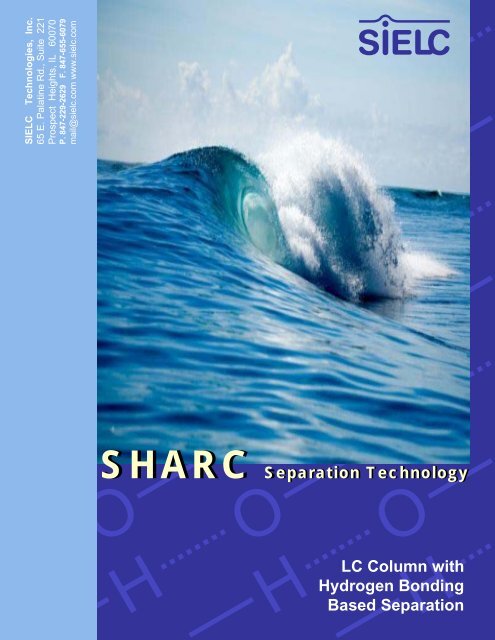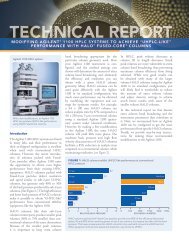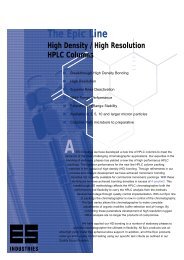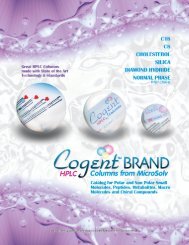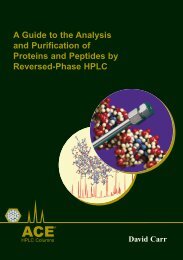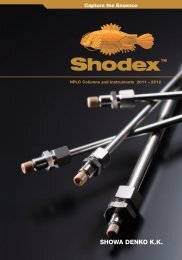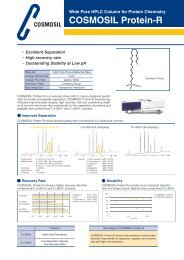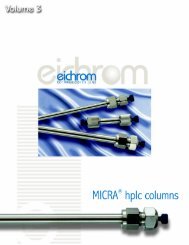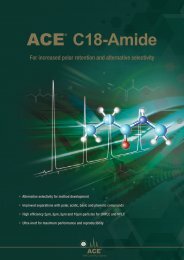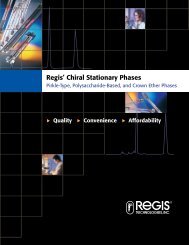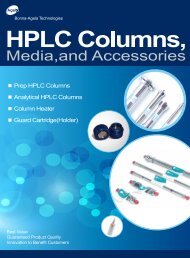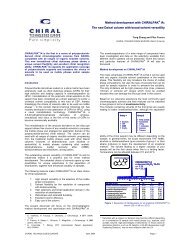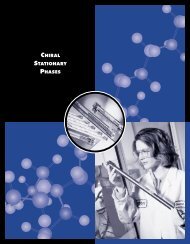Sharc-1 SIELC Column
Sharc-1 SIELC Column
Sharc-1 SIELC Column
Create successful ePaper yourself
Turn your PDF publications into a flip-book with our unique Google optimized e-Paper software.
Method Development TipsHydrogen-bonding interaction offers unique selectivity based on number of “interaction points” available for hydrogen bonding. One of theuseful characteristics to determine retention patterns in hydrogen-bonding mode is the molecular polar surface area (PSA). This calculatedparameter is usually used for prediction of drug transport properties, but we have successfully applied it to hydrogen-bonding interactions.Polar surface area is defined as a sum of surfaces of polar atoms (usually oxygens, nitrogens and heteroatom-attached hydrogens) in amolecule. Since those polar atoms can participate in hydrogen-bonding interaction, estimation of the elution order can often be madebased on PSA. While PSA is a good indicator of retention, it must be noted that it does not account for the accessibility of hydrogeninteractionsites. Not every polar surface participates in intermolecular hydrogen interactions with the stationary phase.The proximity of “interaction points” to each other within amolecule also needs to be considered since molecules can forman intramolecular hydrogen-bonding, which competes withintermolecular interaction between analyte and stationary phase.This reduces retention time in hydrogen-bonding mode. Suchstructural factors provide unique selectivity among structuralisomers, homologs, degradation products and precursors.Since the SHARC 1 is a mixed-mode column, pKa is anotheruseful parameter in method development for these columns.SHARC columns operate in a non-aqueous mobile phase, butsome charge interactions will occur between the stationary phaseand ionizable molecules and contributes to the retention profileHydrogen-bonding interactions were successfully used for theseparation of drugs containing hydroxyl and amino groups (fig.6). The strength of interaction depends on the number ofinteraction points and/or PSA as described above. Trimipraminehas four “interaction points”, but two of the points are not easilyaccessible.<strong>Column</strong>: SHARC 1Size: 3.2 x 100 mmFlow: 0.5 mL/minDetection: UV 270 nm121Trimipramine233NHNNPindololMobile phase: 95% MeCN,5% MeOH with 0.5% Formicacid and 0.05% AmFmMobile phase: 70% MeCN,30% MeOH with 0.5% Formicacid and 0.05% AmFmOOOHNNHNNPyrilamine<strong>Column</strong>: SHARC 1Size: 3.2 x 100 mmFlow: 1.0 mL/minDetection: UV 270 nmOHCH 3HNPseudophedrineOHNH 2OHNorephedrine1. Pyrilamine2. Trimipramine3. Pindolol123Mobile phase:70% MeCN, 30%MeOH with 0.25%Formic acid and0.025% AmFm1. Pseudoephedrine2. Norephedrine3. Phenylephrine4. NorphenylephrineMobile phase: 70%MeCN, 30% MeOHwith 0.25% Formicacid and 0.025%AmFm112HOPhenylephrine32OHCHN 3H0 5 10 15 20 25 min34OHNorephenylephrineMobile phase: 95% MeCN, 5%MeOH with 0.5% Formic acidand 0.05% AmFmFig. 7. The effect of the mobile phase composition on the separationof pseudoephedrine, norephedrine, phenylephrine, andnorphenylephrine.4OHNH 20 5 10 15Fig. 6. The effect of the mobile phase composition on the separationof pyrilamine, trimipramine, and pindolol.Thus, the compound has the lowest PSA (6.5). Pindolol has amuch higher PSA value (57.3) with 4 interaction points which aremore accessible, this causes pindolol to retain longer thantrimipramine and pyrilamine (PSA value 42.9). Resolution andretention of compounds can be adjusted by variations of mobilephase.In another example, a mixture of 4 neurotransmitters (fig. 7)were separated based on their ability to form hydrogen bondswith the SHARC 1 stationary phase. Interactions are very strong.Elution order corresponds to number and strength of interactionpoints as well as PSA numbers for pseudoephedrine (32.3),norephedrine (46.3), phenylephrine (52.5) and norphenylephrine(66.5). Pseudoephedrine and norephedrine have 2 interactionpoints, phenylephrine and norphenylephrine have three. Thepresence of N-methyl substitution reduces hydrogen-bondinginteraction of nitrogen functional groups and reduces retention.This approach can be used for the separation of unsubstitutedand N-substituted amines..min4
SHARC- 1 ApplicationsXanthines are good candidates for separation by hydrogenbonding with SHARC1 (fig. 8). They are capable of formingmultiple hydrogen bonding interactions. The theory of PSA andaccessibility of groups explains the retention time and order ofelution very well. Caffeine (PSA-61.8), 3-methylxanthine (PSA-83,6), 1-methylxanthine (PSA-83.6) and xanthine (PSA-94.4)eluted according to the PSA number. In caffeine, three of thenitrogens have substituted methyls, which makes these groupsunavailable for hydrogen interaction. 3-methyl-, and 1-methylxanthine only have one substitution and thus are retainedlonger. Xanthine which has no substitution on the nitrogen isretained the longest.Nucleobases, like xanthines, have a lot of interaction pointsdue to the presence of multiple nitrogens and oxygens.Nucleobases in most cases elute according the number ofinteraction poinyts and PSA value (fig. 9). Thymidine (3interaction points, PS value of 104), uridine (4 interaction points,PS value of 124), adenosine (4 interaction points, PS value of139), guanosine (5 interaction points, PS value of 159 ), andcytidine (4 interaction points, PS value of 139) were separatedbased on hydrogen-bonding properties. Some abnormality wasobserved in case of cytidine and it was attributed to betteraccessibility of groups contributing to hydrogen-bonding.1. Thymidine2. Uridine3. Adenosine4. Guanosine5. CytidineHO12 31OHNO NNHOO2 34 5<strong>Column</strong>: SHARC 1Size: 3.2 x 100 mmFlow: 1.0 mL/minDetection: UV 270 nmOH OHOH OHOH OHThymidine Uridine AdenosineONH 2N NHNN N NHHO2N OHOOOOH OHGuanosineHOOH OHCytidineMobile phase: MeCN/MeOH85/15 with 0.5% Formic acid with0.05% AmFmMobile phase: MeCN gradientfrom 100% to 75%, MeOHgradient from 0% to 25% in 15min with 0.5% Formic acid with0.05% AmFm4 50 2.5 5 7.5 10 12.5 15Fig. 9. The effect of mobile phase composition on the separationof nucleobasesOONNHOHOONNminNH 2NNON123CaffieneXanthine0 1 2 3 4 5<strong>Column</strong>: SHARC 1Size: 3.2 x 100 mmMobile phase: MeCN/MeOH 95/5 with0.1% Formic acid and 0.01% AmFmFlow: 1.0 mL/minDetection: UV 270 nmFig. 8. The separation of caffeine, 3-methylzanthine, 1-methylxanthine, and xanthine.1. Pyridine2. 3-Aminopyridine3. 4-Aminopyridine4. 2-AminopyridinePyridine1 21ONNN4-Aminopyridine4O3NONHHNN42 4 3min3-Methylxanthine1-Methylxanthine1. Caffeine2. 3- Methylxanthine3. 1- Methylxanthine4. XanthineIsomers of aminopyridine were separated by hydrogen-bonding.All the aminopyridines have the same PSA value (fig. 10).Therefore, the difference in retention time was attributed toaccessibility of hydrogen-bonding sites and basicity of theanalytes. The order of elution for aminopyridines can be changedby variation of the mobile phase.The separation of phthalic acid isomers is another example ofthe separation of compounds with identical numbers of interactionsites and PSA value (74.6) (fig. 11). This example alsodemonstrates that when intramolecular bonding exists (phthalicacid) compounds are less retentive compared to the other isomers(terephthalic and isophthalic acids)NNH 2NHN<strong>Column</strong>: SHARC 1Size: 3.2 x 100 mmFlow: 1.0 mL/minDetection: UV 270 nm3-Aminopyridine0 2 4 6 8 10 12Mobile Phase: Acetonitrileand MeOH (95/5) with 0.5%FA and 0.05% AmFmMobile Phase: Acetonitrile andMeOH (50/50) with 0.5FA and0.05% AmFmFig. 10. The separation of isomers of AminopyridinesOONNNHNOHNONHHNNNH 2N NH 2min2-Aminopyridine5
Mixtures of basic and acidic compounds containing hydroxy andamino groups can be separated in one analysis utilizing hydrogenbondinginteraction between the stationary phase and the hydrogenbondinggroups of analytes (fig. 12). The method was used for theseparation of three neurotransmitters (homovanillic acid, DOPAC anddopamine).However, the retention time of dihydroxybenzoic acids is harder topredict based on PSA number alone, because all four compoundshave the an identical PSA value (fig. 13). If compounds have anidentical PSA index, accessibility and internal hydrogen bonding canbe considered in explaining elution order. Acids, which can undergointernal hydrogen bonding (2,6-dihydroxybenzoic acid) retain lessthan the acids where hydrogen interactions are less restricted, suchas 3,5- and 2,5- dihydroxybenzoic acids.Highly effective separation and selectivity can be obtained formolecules containing very different numbers of hydrogen-bondingsites. A good example is nucleosides and nucleobases (fig. 14),where, depending on the conditions, various order of elution can beobtained.1. Homovanillic acid2. DOPAC3. DopamineOHOOHO1HOHO<strong>Column</strong>: SHARC 1Size:3.2 x 50 mmFlow:1.0 mL/minMobile phase: Gradient MeCN/MeOH100/0 to MeCN/MeOH 30/70 with 0.5%Formic acid with 0.05% AmFm in 7 minDetection: UV 270 nm2OOHHOHO3NH 21. Phthalic acid2. Terephthalic acid3. Isophthalic acid<strong>Column</strong>: SHARC 1Size:3.2 x 100 mmFlow:1.0 mL/minDetection: UV 270 nmPhthalic Acid Terephthalic Acid Isophthalic Acid0 4 8 12Mobile phase: MeCN100% with 0.5% Formicacid with 0.05% AmFmMobile phase:MeCN/MeOH 98/2 with0.2% Formic acid with0.02% AmFmFig. 11. The effect of mobile phase composition on the separationof phthalic, terephthalic, and isophthalic acid1OO2OHOH3HO4OminOOHOOHOOH<strong>Column</strong>: SHARC 1Size: 3.2 x 100 mmFlow: 1.0 mL/minMobile phase: MeCN100% with 0.5% Formicacid with 0.05% AmFmDetection: UV 270 nm1. 2, 6-Dihydroxybenzoic acid2. 2, 4-Dihydroxybenzoic acid3. 3, 5-Dihydroxybenzoic acid4. 2, 5-Dihydroxybenzoic acid0 2 4 6 8min0 1 2 3 4 5 6 7Fig. 12. The separation of homovanillic acid, DOPAC, and dopamine.minFig. 13. The separation of dihydroxybenzoic acids using varyingmobile phases.<strong>Column</strong>: SHARC 1Size: 3.2 x 100 mmFlow: 1.0 mL/minDetection: UV 270 nm1Mobile phase:OHOHMeCN/MeOH 50/50 with0.5% Formic acid withCytidine0.05% AmFm 1. Cytidine222. Cytosine1NH 2NHNCytosineOHONNH 2O NOMobile phase:MeCN/MeOH 95/5 with0.5% Formic acid with0.05% AmFmHydrogen bonding separation can be demonstrated in Triton X100 example where degree of retention is correlated to the numberof oxygens in the molecule<strong>Column</strong>: SHARC 1Size: 4.6 x 150 mmFlow: 1.0 mL/minMobile phase: GradientMeCN/MeOH 100/0 toMeCN/MeOH 50/50 with0.1% Formic acid with0.01% AmFm in 12 minDetection: UV 270 nmOO n0 5 10 15 minFig. 14. The effect of mobile phase composition on the separation ofcytidine and cytosine0 2 4 6 8 10Fig. 15. The separation of components of Triton X 100 surfactantmin6www.sielc.com


